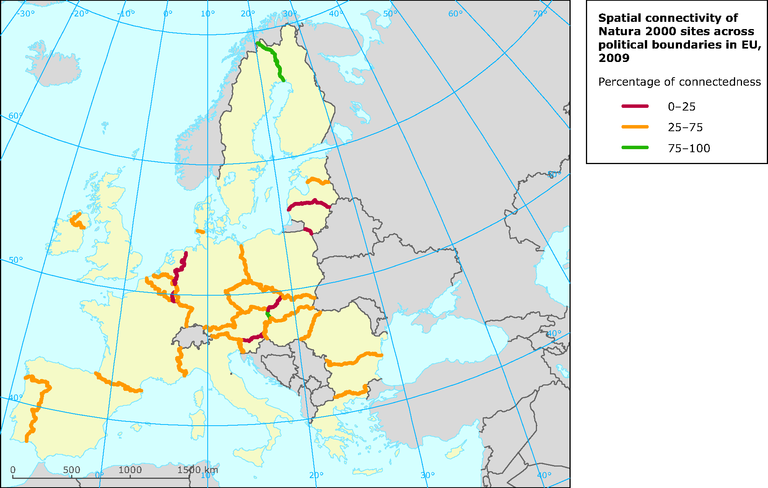One of the main objectives set out in the Habitats Directive is to build an 'ecologically coherent' network. The network is ecologically coherent if it includes sufficient sites — in number and area — distributed over a wide geographic area, representing the full range of variation of the habitat types and species mentioned in the Habitats Directive. An ecologically coherent network should contribute to achieving favourable conservation status of those habitat types and species. An important additional feature of ecological coherence is 'connectivity' between the sites of the network. An assessment was made of spatial and functional connectivity across 34 terrestrial political borders of the European Union.
Spatial connectivity was measured by a quantified proportion of Natura 2000 sites on the both sides of a boundary against total border length. Functional connectivity was measured by the dispersal success of 192 reptile, amphibian, invertebrate and plant species listed in the Annex II of the Habitats Directive. The functional connectivity was judged to be present if the same species was present in selected site-pairs on political borders where each site represented a different country.
Spatial and functional connectivity was positively correlated. However, a few outlying examples showed that good spatial connectivity does not necessarily bring good functional connectivity and that good connectivity is not always possible because of different habitats and/or different management on both sides of border. We must be mindful that each political boundary has its own history with a unique subset of factors influencing Natura 2000 site selection and management, thus resulting in the near absence of common patterns. Species occurring in a geographically restricted area (i.e. spread between only two or three member states) tended to show the highest levels of connectivity.
In conclusion, connectivity — spatial and functional — across national borders is relatively good, but the overall coherence of the network could be further improved. That would require greater analysis, principally on functional connectivity. The study above did not investigate connectivity for the birds component of Natura 2000.
Spatial connectivity of Natura 2000 sites across political boundaries in different parts of the European Union

Functional connectivity of Natura 2000 sites across political boundaries in EU, 2009

Document Actions
Share with others